Ever since Union Road Minister Nitin Gadkari stated a 13-14% GST cut on Flex Fuel Hybrid EVs, the news spread like wildfire. Folks have glued their eyes on the upcoming hybrid models of cars like the Toyota Innova HyCross, the world’s first and foremost flex fuel hybrid EV.
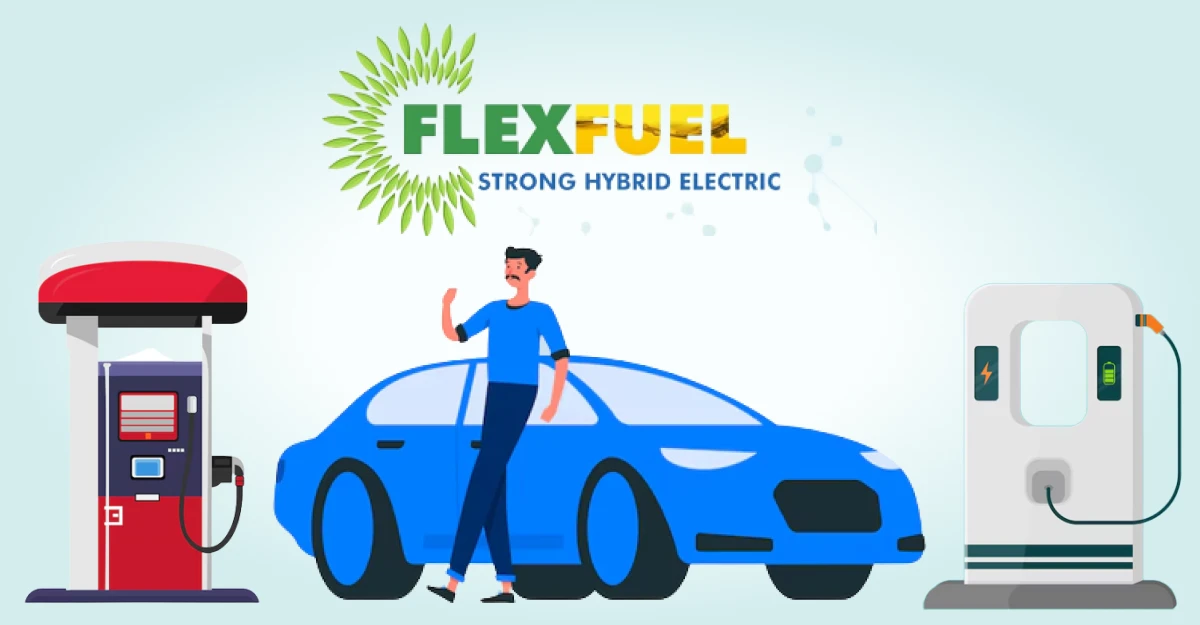
Now the questions that arise are- What are Flex Fuel Hybrid EVs? What are its potential benefits? Are they really good for the environment?
Let’s find out!
(A) What are Flex Fuel Hybrid EVs?
As the term suggests, Flex Fuel Hybrid Electric Vehicles (FFV-SHEVs) combine the benefits of both hybrid technology and flexible fuel capability.
Hybrid Technology
- FFV-SHEVs have an electric powertrain (battery and electric motor) alongside an internal combustion engine (ICE).
- The electric motor assists the ICE during acceleration, reducing fuel consumption and emissions.
- When braking or coasting, the electric motor acts as a generator, recharging the battery.
Flexible Fuel Capability
- FFV-SHEVs can run on a variety of fuels, including gasoline and ethanol blends.
- The key feature is their ability to use E85, which is a blend of 51% to 83% ethanol and gasoline.
- E85 is a renewable fuel made from corn or other plant materials.
Sounds complicated?
Let me explain in simple terms…
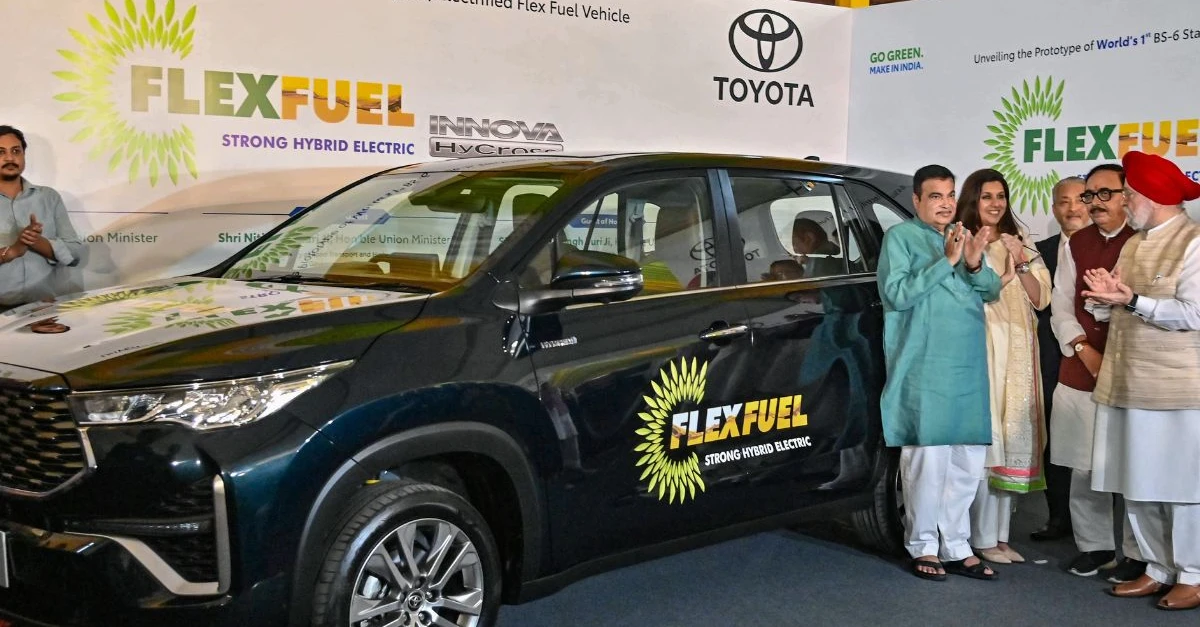
So, imagine a scenario where you’re driving through the city in your new car. The fuel gauge shows that you’re running low. You press a button, and your car smoothly switches to electric power. Your passengers don’t even notice the change.
After a while, you spot a fuel station. You pull in and decide to fill up with a biofuel mix instead of regular gasoline. Your car can run on different types of fuel, so this switch is easy. You drive off again, feeling good about using a cleaner fuel that helps the environment.
Is that even possible? You may wonder.
Well, yes this isn’t just a dream; it’s becoming a reality with Flex Fuel Hybrid Electric Vehicles (FFHEVs). These cars can run on gasoline, biofuels like ethanol, and electricity. This means you have more options and can help reduce pollution.
Car companies are now making these flexible-fuel cars. For example, they can use E85, a fuel that’s 85% ethanol and 15% gasoline. Using more ethanol helps cut down on carbon emissions. Plus, if biofuels aren’t available, the electric motor can keep you going.
This is important because a lot of pollution comes from cars. In India, the government wants to cut pollution by 45% by 2030. FFHEVs are part of the solution. They help reduce our dependence on traditional fuels and lower the pollution that harms our planet.
(B) Key Components of FFHEVs
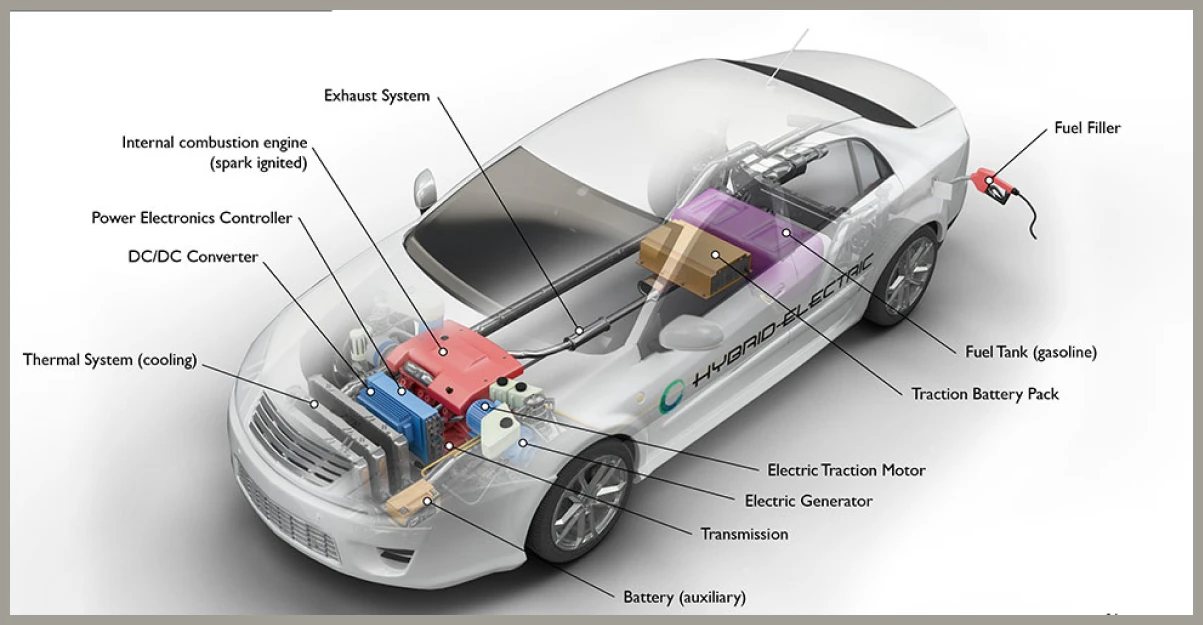
- Battery (Auxiliary): A small battery that provides the initial electricity to start the car and powers accessories like lights and the radio.
- DC/DC Converter: This device changes the high-voltage power from the main battery to a lower voltage to run accessories and recharge the auxiliary battery.
- Electric Generator: Generates electricity from the wheels when you brake and sends it back to the battery.
- Electric Traction Motor: Drives the wheels using power from the main battery. In some cars, this motor can also generate electricity during braking.
- Exhaust System: Removes exhaust gases produced by the engine, with a special part that reduces harmful emissions.
- Fuel Filler: The place where you attach the fuel nozzle to fill up the tank with gasoline or ethanol.
- Fuel Tank (Gasoline): Stores the fuel (gasoline or ethanol) for the engine.
- Internal Combustion Engine (Spark-Ignited): Uses fuel injected into the engine, mixed with air, and ignited by a spark to create power.
- Power Electronics Controller: Manages the flow of electricity from the battery to the motor, controlling the motor’s speed and torque.
- Thermal System (Cooling): Keeps the engine, electric motor, and other components at the right temperature to prevent overheating.
- Traction Battery Pack: The main battery that stores electricity for the electric motor.
- Transmission: Transfers power from the engine and/or electric motor to the wheels to move the car.
(C) How do Flex Fuel Hybrid Electric Vehicles work?
Flex Fuel Hybrid Electric Vehicles combine the best of both worlds: they can run on gasoline, ethanol blends, and electricity. Here’s how they work-
Dual Power Sources
- Internal Combustion Engine (ICE): This engine uses traditional fuels like gasoline or ethanol blends to power the car.
- Electric Motor: This motor uses energy stored in a battery to power the car.
Switching Between Power Sources
- When you’re driving, the car can switch between the engine and the electric motor, or use both at the same time.
- If the battery runs low, the engine can take over or recharge the battery through a process called regenerative braking.
Regenerative Braking
When you brake, the energy from the rotating wheels is converted into electricity and stored back in the battery.
The key components work together to ensure the car runs efficiently and switches between power sources smoothly. The electric motor helps save fuel and reduce emissions, while the internal combustion engine ensures you always have enough power.
This makes FFHEVs a great option for a cleaner and more flexible driving experience.
(D) Real World Example
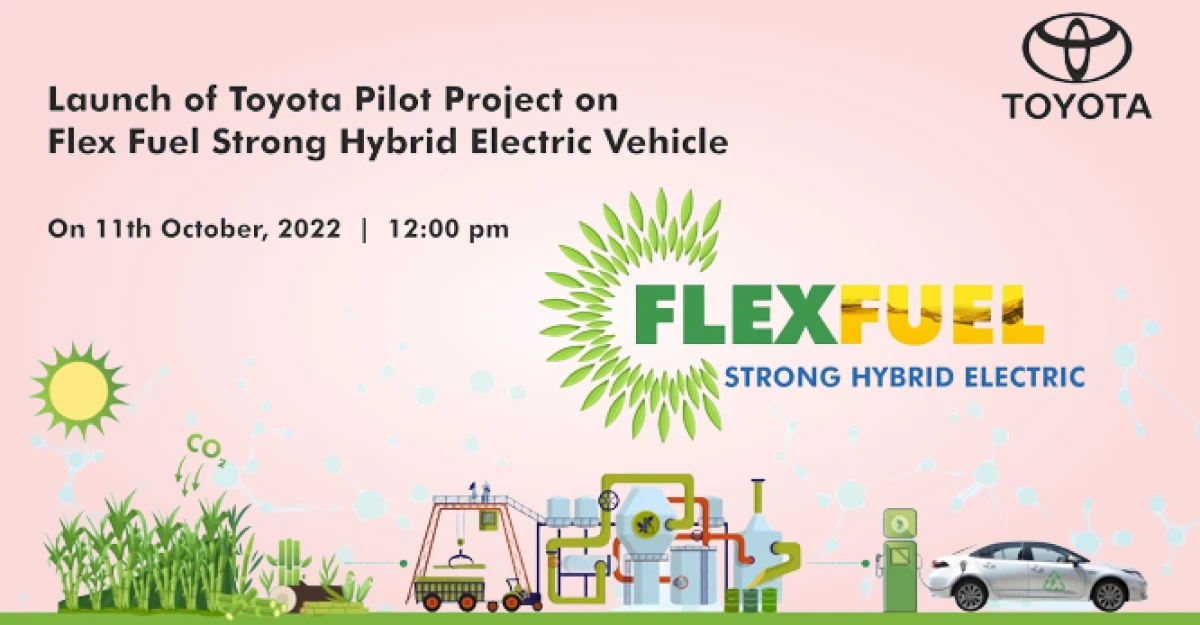
FFV-SHEVs offer a practical approach to carbon reduction by combining hybrid efficiency with flexible fuel options. Some of the recent examples are-
- The American Coalition for Ethanol (ACE) tested a standard hybrid FFV. Their results showed that FFV-SHEVs can achieve low carbon intensity (CI) similar to battery electric vehicles (BEVs) over their lifecycle.
- Toyota recently launched India’s first FFV-SHEV, emphasizing the benefits of this technology.
(E) Reducing GDP Emission Intensity through Flex Fuel Hybrid EVs
India has a big goal- to cut its greenhouse gas emissions by 45% per unit of GDP by 2030. This means producing less pollution for every bit of economic growth. Since cars and trucks cause 40% of India’s pollution, reducing vehicle emissions is very important.
Let’s look at the key aspects involved in it-
(E.1) Challenges with EVs (Electric Vehicles)
Switching to EVs sounds like a good idea, but it has some problems-
- Battery Production: EV batteries need metals like nickel, cobalt, and lithium. Mining and processing these metals release a lot of greenhouse gases.
- Electricity Source: In India, 80% of electricity comes from burning coal, which pollutes a lot.
(E.2) Alternative Fuels
Using alternative fuels could help, but there are issues with each option-
- Biogas: It can’t be produced in large amounts because it comes from limited feedstock.
- Hydrogen: It’s expensive and there isn’t enough infrastructure for it yet.
(E.3) The Potential of Flex Fuel Vehicles
Flex-fuel vehicles, which can run on ethanol-blended petrol, offer a practical solution. Ethanol is made from fermenting sugar in grains like corn or sugarcane. Since India is a major sugar producer, this fuel source is readily available.
For example- Brazil has been blending ethanol with petrol since 1976. They have successfully converted 90% of their light-duty vehicles to flex fuel. This sets a good example for India.
(E.4) Ethanol Production Challenges
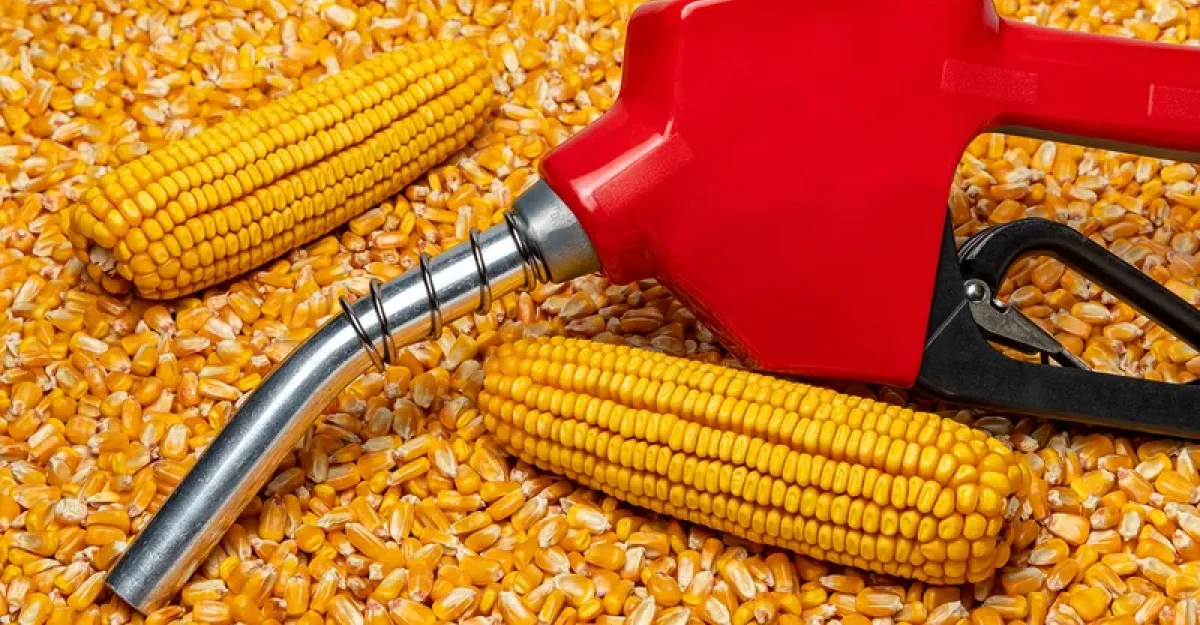
To achieve a 20% ethanol blend in fuel by 2025, India needs to produce 1,000 crore liters of ethanol each year. Right now, India produces only about half of that amount, so increasing production will take time.
(E.5) Role of Hybrid Vehicles
Hybrid vehicles combine a gasoline or diesel engine with an electric motor. They offer several benefits-
- Regenerative Braking: This system captures energy during braking to recharge the battery, so they don’t need a lot of charging stations.
- Lower Emissions: Hybrids emit less carbon dioxide than both regular petrol cars and pure EVs. For example, hybrids emit 167 grams of CO2 per kilometer, compared to 244 grams for petrol cars and 187 grams for EVs.
(E.6) Advantages of Flex Fuel Hybrid Electric Vehicles
- Higher Ethanol Use: FFV-SHEVs can operate on E85, which reduces dependence on fossil fuels.
- Fuel Efficiency: They can run in electric-only mode (EV mode) for a significant time, shutting off the ICE.
- Reduced Emissions: When using E85, FFV-SHEVs emit fewer greenhouse gases compared to regular gasoline.
(E.7) Disadvantages of Flex Fuel Hybrid EVs
Flex-fuel hybrid EVs could reduce the carbon footprint even more by combining ethanol’s benefits with hybrid technology. However, they face several challenges viz.-
- Cost: These vehicles are expensive to make because they need special parts to handle ethanol’s corrosive nature.
- Engine Damage: Regular use of ethanol-blended fuel can damage engines, causing rust and reducing fuel quality.
- Lower Energy Density: Ethanol has less energy than petrol, leading to lower mileage and higher running costs.
- Supply Issues: Ethanol isn’t as widely available as regular fuel, although the electric motor can help with this.
(E.8) Food Security Concerns
Ethanol production in India relies on food grains from the central food pool, which is meant for underprivileged people. Increasing ethanol production requires more land, which could lead to land use changes and higher carbon footprints, as seen in the US with corn ethanol.
Note: When it comes to the automobile sector in India, people often wonder- Can Tata Motors surpass Maruti Suzuki with the help of EVs? Go through the article, and you’ll get to know it!
(F) Wrap-up
In a nutshell, Flex Fuel Hybrid EVs (FFHEVs) are a promising solution for India’s future. By using both ethanol and electricity, these vehicles can significantly reduce our reliance on oil imports and cut down on greenhouse gas emissions. With India’s goal to have 20% ethanol-blended petrol at all fuel pumps by 2025, we could save an estimated ₹30,000 crore and reduce emissions by 10 million metric tons. FFHEVs represent a major step towards a cleaner, more sustainable future.
Thank you for reading the full article… Feel free to share your thoughts in the comments section below!

